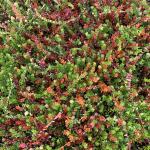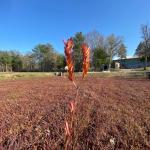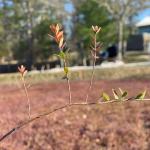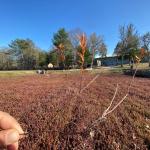This past week proved to be a challenging time to sweep! Despite fairly high winds and cold temperatures, cranberry weevils have been picked up. Populations of weevil are expected to continue to grow as more weevils move out of the woods and off blueberry and onto cranberry. Your insecticide choices for management are Avaunt, Actara and Fanfare. Remember Fanfare has a 100-day or 110-day PHI (Check with your handler!) on export fruit. Green spanworm populations are out there and ranged in size from tiny to up to ½”, and we are picking up 4s and 6s. Consider treating if you find more than 10 spanworm on average, although the threshold is 18!! Avaunt is your best choice, but Intrepid and Delegate are also options. Scale damage is starting to be evident – orangy dieback areas may indicate scale at work. Contact Marty if you think you have an infestation.
Upright Dieback applications should go on as soon as possible. Frost nights have made it very difficult to time this spray. Export fruit has a 120-day PHI and no use after bud elongation, which is very close to right now. Please see photos.
Our disease diagnostic lab is available for your service. In the next two weeks, if you have any immediate disease field visit or identification or diagnostic requests for upright dieback or Phytophthora root rot, please contact Leela Uppala (508-296-5330) or suppala@umass.edu. Although our typical turnaround time is 2 weeks for plating and microscopic identification of samples, considering the rapid progression of bloom, we will get results back to you in a week. If you have confirmed diagnosis of upright dieback (typical symptoms are presented in the images below), consider fungicide applications at early bud break/bud expansion (which is around now for most of the cultivars) if more than 5% uprights are infected.
We will be hosting a Bogside Workshop this coming Thursday May 25 from 8-10 AM. One contact hour will be offered. We will cover weeds, pathology, nutrition, and issues of the day. To participate, contact Robyn Hardy at 508-970-7635 or rmhardy@umass.edu.
For those of you that held late water (LW), please note management after late water is as important as the practice itself to reap the benefits of this cultural practice. Some of the best management practices after late water flood are presented below. Please also refer to the Chart Book pages 90-92 for more information.
Irrigation: For at least 2 weeks after the LW flood is withdrawn, there should be no need to irrigate (unless protecting for frost). Following this period, schedule irrigation based on soil moisture status determined by sensors or tensiometers.
Frost protection: After LW flood, buds are sensitive to frost injury. Frost management after the LW should be based on the actual duration of the flood, rather than the appearance of the buds.
1-week early spring flood: No impact on frost tolerance. Protect the buds based on appearance.
>1 - 2 weeks LW flood: Protect the bogs for 27˚F
> 2 weeks LW flood: Protect the bogs for 30˚F
Fertilizer use: LW bogs respond readily to fertilizer. Nitrogen (N) dose should be reduced to avoid overgrowth. However, do not decrease fertilizer N by more than 40%; the impacts would be adverse on the following season crop. The best tactic is to add no fertilizer for at least 2 weeks after the flood withdrawal and then time your applications by the plant’s development. No fertilizer should be needed until bloom.
< 3 weeks flood: standard fertilizer regime
> 3 weeks flood: Reduce N dose (30-40%) by eliminating the spring application.
Herbicide usage: Casoron and QuinStar may be applied after the LW flood is withdrawn for dodder management. After LW, low rates of Casoron (<40 lbs/acre) are recommended. Quinstar could offer management of dodder, yellow loosestrife (YLS) and other broadleaf grasses. Up to two applications of QuinStar can be applied at 30 days interval @ 8.4 oz/acre. No other preemergence herbicides are recommended after LW. POST herbicides can be applied when weeds have emerged, according to the label.
Disease management: LW can be an excellent cultural control strategy against fruit rot.
*Processed fruit and fresh fruit Howes, year of the LW flood - Use reduced rates (never use less than the recommended rate listed on the fungicide label) and number of applications of fungicides. Fungicide application intervals may be extended to every 10 or 14 days depending on bloom. Fungicides may be eliminated on processed-fruit beds if the keeping quality is forecast to be good to excellent. If one application is to be made, apply at 50% bloom. If two fungicide applications are made, apply the first at 10% bloom and the second two weeks later. Reduced fungicide rates should be employed, especially for Howes, which has greater resistance to rot.
*First year after LW has been held - Fungicide applications and rates can still be reduced without sacrifice in fruit quality.
*Second year after LW has been held - Fungicide applications and rates should be increased to a normal schedule. Otherwise, fungal inoculum will increase and may cause significant field and storage rot losses.



